In the Southeast region, most livestock operations are primarily based on perennial warm-season grasses. Due to the seasonality of production, there is a need to provide supplemental feed for livestock during the fall and winter months by stockpiling forages, feeding hay or non-forage feedstuff, or planting cool-season annuals. Annual cool-season forages have high forage quality that can extend the forage production and distribution, which decreases the need for feeding hay. Selecting the proper forage species adapted to your location, weather, soil type, and animal`s nutrient requirements is essential.
The planting window for cool-season forages ranges from late August through early November, depending on your location and planting strategy. When planting in a prepared seedbed, you may be able to sow the seeds in late August/early September. When overseeding into warm-season perennial grass stands, it is recommended to plant in late September through October when the perennial grass becomes dormant to avoid competition at germination. With this method, grazing or mowing must be conducted before planting to remove excessive forage mass and leave
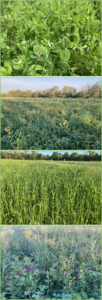
a two-inch stubble height which will favor seed-soil contact upon no-till planting.
Before selecting the forage(s) to be used, one should consider the plant and animal requirements and the level of management input required. Proper nutrient replenishment and harvest management will support the establishment and forage production. Most cool-season forage species can be used either in monoculture or mixture. A mixture of forages improves distribution throughout the season, and when including legume (s), it helps to input organic nitrogen (N) into the forage system.
Key considerations before planting:
- Soil test before planting to amend pH and apply fertilizers based on soil report recommendations.
- Conduct proper weed control and land preparation before sowing seeds:
- When using a clean seedbed, land should be well prepared (disked, harrowed, etc.) to achieve appropriate planting conditions.
- When overseeding perennial warm-season grass stands, removal of excessive forage mass is required to allow for proper seed-soil contact.
- Use certified, high-quality seeds to avoid introducing unwanted plants into your pastures.
- Using proper seeding rate and seed depth is critical.
- Use mixtures to improve forage distribution and quality throughout the season. In this case, adjustments to the individual seeding rates will be necessary when mixing species. For help in adjusting the seeding rates, please consult your local Extension agent.
- Incorporating legumes can improve diet quality and helps with the input of organic N into the forage system.
- Plan to split and apply the total fertilizer rate for nitrogen (N) and potassium (K) to optimize use by the plants and decrease losses.
Choosing your forage base for the cool season period
The choice of forage species should be based on adaptation to soil and climatic conditions in the area, compatibility with animal requirements, operation goals, management requirements, costs, and expected animal performance. Below is an overview of the main forage species used in the region.

Oat (Avena sativa) is a bunchgrass with high forage quality that does not tolerate wet feet and is susceptible to freeze injury. It can be managed under hay/baleage production or under grazing. Generally, it can be grazed earlier than rye and heads out slightly later in spring. The recommended seeding rate ranges from 90 to 120 lbs. pure live seed (PLS)/acre, and the seeding depth is one to two inches.
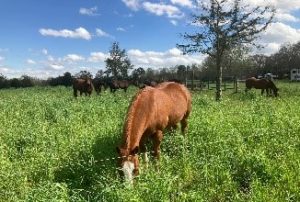
Rye (Secale cereale) is a bunchgrass, more cold tolerant than oats, and generally yields higher than either oats or wheat. It is well-adapted to sandy soils. The recommended seeding rate ranges from 90 to 120 lbs. PLS/acre, and the seeding depth is ½ inch to ¾ inch deep.
Wheat (Triticum aestivum) is a bunch of grass, less susceptible to freeze injury than oats. It is a dual-purpose crop (i.e., grazing and grain production). The recommended seeding rate ranges from 90 to 120 lbs. PLS/acre, and the seeding depth should be one to two inches. Hessy fly can be an issue.
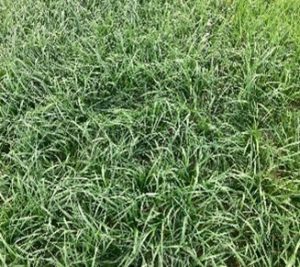
Ryegrass (Lolium multiflorum) is a bunchgrass with shiny, smooth leaves with its forage distribution concentrated mid- to late-winter. It can be used for hay production or under grazing management. It is a good companion forage to other cool-season species that grow earlier to extend the production season. Recommended seeding rate ranges from 15 to 25 lbs. PLS/acre and seeding depth is ½ inch to ¾ inch.

Triticale is a hybrid between wheat and rye. It is well adapted to the southern USA and has high forage quality and disease resistance. Under grazing management, mixtures are recommended to optimize results once it does not respond well to close grazing. It can also be used for hay or silage production. The recommended seeding rate ranges from 100 to 120 lbs. PLS/acre, and the seeding depth should be one to two inches.
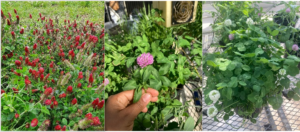
Clovers (Trifolium spp.) require fertile soil and a soil pH of around 6.
- Arrowleaf – grows later in the season and has non-hairy arrow-shaped leaves. The recommended seeding rate is 5 to 10 lbs. PLS/acre, and the seeding depth is ¼ to ½ inch.
- Ball – grows on various soil types and has non-hairy oval leaflets and white flowers. The seeding rate recommended is 2 to 3 lbs. PLS/acre, and the seeding depth should be from ¼ to ½ inch.
- Berseem – is adapted to a wide range of soil types and has non-hairy elongated leaflets. Recommended seeding rate ranges from 12 to 18 and 2 to 2.5 lbs. PLS/acre for broadcast and drilling, respectively, and seeding depth should be from ¼ to ½ inch.
- Crimson – is a reseeding annual adapted to fertile, well-drained soils and has dense haired leaves and stems. The recommended seeding rate is 20 to 30 lbs. PLS/acre, and the seeding depth should be from ¼ to ½ inch.
- White – perennial species and has non-hairy, oval leaflets. The recommended seeding rate is 2 to 3 lbs. PLS/acre and seeding depth should not exceed ¼ to ½ inches.
- Red – biennial species that does not tolerate poorly drained soils and has hairy, oval leaflets. The recommended seeding rate is 4 to 9 lbs. PLS/acre, and the seeding depth should be from ¼ to ½ inch.

Vetch (Vicia spp) requires well-drained, fertile soils. Hairy (V. villosa), (V. sativa), and bigflower (V. grandiflora) vetch are viny annuals with white, purple, or pale-yellow flowers. Recommended seeding rate is 15 to 20 lbs. PLS/acre, and the seeding depth of ½ to one inch.
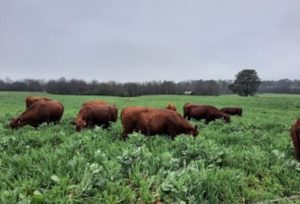
Brassicas include varieties of rapeseed, radish, turnip, kale, and others. They are quick to mature and generally can be grazed around 60-d after planting. Under grazing, animals often need some time to adjust to the taste to start grazing, so using these species in mixtures is a good strategy because it helps to dilute its proportion with other species. Brassicas should be planted up to ¼ inch deep, and the seeding rates range from 2 to 5 lbs. PLS/acre, depending on the species.
Seeding rates need to be adjusted when planting forage mixtures to guarantee the best conditions for species to germinate and decrease competition for sunlight, water, and nutrients. The use of mixtures can help improve forage distribution, production, and diversity in forage systems. When using legumes, biological N fixation can range from 20 to 150 lbs. N/acre, depending on the proportion of legumes in the mixture and management implemented. Consult your local Extension agent for help selecting recommended forage varieties and to get more information about the establishment and management of cool-season species.
Submitted by Liliane Silva, Ph.D., Assistant Professor and Extension Specialist,
Forage-Livestock Systems, Department of Animal and Veterinary Sciences, Clemson University
Clemson University Cooperative Extension Service offers its programs to people of all ages, regardless of race, color, gender, religion, national origin, disability, political beliefs, sexual orientation, gender identity, marital or family status and is an equal opportunity employer.
